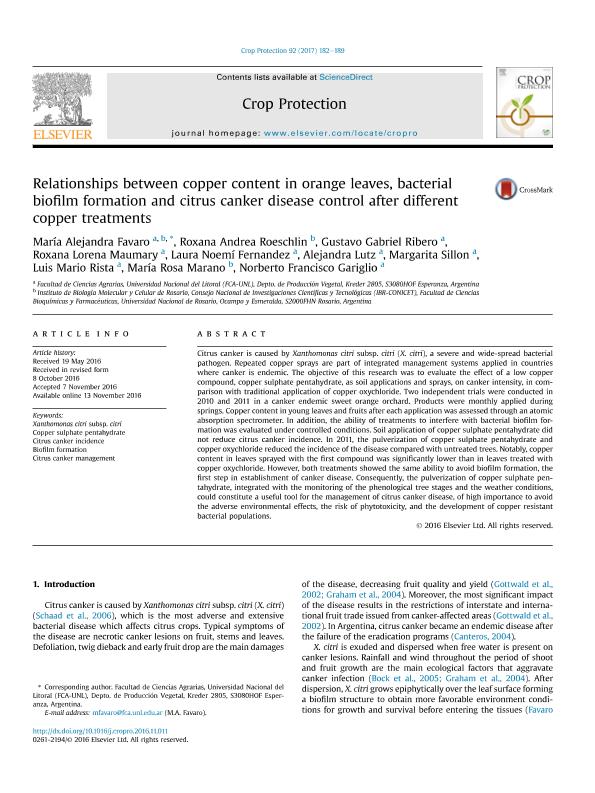Artículo
Relationships between copper content in orange leaves, bacterial biofilm formation and citrus canker disease control after different copper treatments
Favaro, María Alejandra ; Roeschlin, Roxana Andrea
; Roeschlin, Roxana Andrea ; Ribero, Gustavo Gabriel
; Ribero, Gustavo Gabriel ; Maumary, Roxana Lorena
; Maumary, Roxana Lorena ; Fernandez, Laura Noemí
; Fernandez, Laura Noemí ; Lutz, Alejandra
; Lutz, Alejandra ; Sillon, Margarita; Rista, Luis Mario; Marano, María Rosa
; Sillon, Margarita; Rista, Luis Mario; Marano, María Rosa ; Gariglio, Norberto Francisco
; Gariglio, Norberto Francisco
 ; Roeschlin, Roxana Andrea
; Roeschlin, Roxana Andrea ; Ribero, Gustavo Gabriel
; Ribero, Gustavo Gabriel ; Maumary, Roxana Lorena
; Maumary, Roxana Lorena ; Fernandez, Laura Noemí
; Fernandez, Laura Noemí ; Lutz, Alejandra
; Lutz, Alejandra ; Sillon, Margarita; Rista, Luis Mario; Marano, María Rosa
; Sillon, Margarita; Rista, Luis Mario; Marano, María Rosa ; Gariglio, Norberto Francisco
; Gariglio, Norberto Francisco
Fecha de publicación:
11/2016
Editorial:
Elsevier
Revista:
Crop Protection
ISSN:
0261-2194
Idioma:
Inglés
Tipo de recurso:
Artículo publicado
Clasificación temática:
Resumen
Citrus canker is caused by Xanthomonas citri subsp. citri (X. citri), a severe and wide-spread bacterial pathogen. Repeated copper sprays are part of integrated management systems applied in countries where canker is endemic. The objective of this research was to evaluate the effect of a low copper compound, copper sulphate pentahydrate, as soil applications and sprays, on canker intensity, in comparison with traditional application of copper oxychloride. Two independent trials were conducted in 2010 and 2011 in a canker endemic sweet orange orchard. Products were monthly applied during springs. Copper content in young leaves and fruits after each application was assessed through an atomic absorption spectrometer. In addition, the ability of treatments to interfere with bacterial biofilm formation was evaluated under controlled conditions. Soil application of copper sulphate pentahydrate did not reduce citrus canker incidence. In 2011, the pulverization of copper sulphate pentahydrate and copper oxychloride reduced the incidence of the disease compared with untreated trees. Notably, copper content in leaves sprayed with the first compound was significantly lower than in leaves treated with copper oxychloride. However, both treatments showed the same ability to avoid biofilm formation, the first step in establishment of canker disease. Consequently, the pulverization of copper sulphate pentahydrate, integrated with the monitoring of the phenological tree stages and the weather conditions, could constitute a useful tool for the management of citrus canker disease, of high importance to avoid the adverse environmental effects, the risk of phytotoxicity, and the development of copper resistant bacterial populations.
Archivos asociados
Licencia
Identificadores
Colecciones
Articulos(CCT - SANTA FE)
Articulos de CTRO.CIENTIFICO TECNOL.CONICET - SANTA FE
Articulos de CTRO.CIENTIFICO TECNOL.CONICET - SANTA FE
Articulos(IBR)
Articulos de INST.DE BIOLOGIA MOLECULAR Y CELULAR DE ROSARIO
Articulos de INST.DE BIOLOGIA MOLECULAR Y CELULAR DE ROSARIO
Citación
Favaro, María Alejandra; Roeschlin, Roxana Andrea; Ribero, Gustavo Gabriel; Maumary, Roxana Lorena; Fernandez, Laura Noemí; et al.; Relationships between copper content in orange leaves, bacterial biofilm formation and citrus canker disease control after different copper treatments; Elsevier; Crop Protection; 92; 11-2016; 182-189
Compartir
Altmétricas



